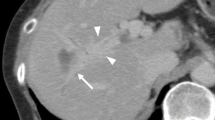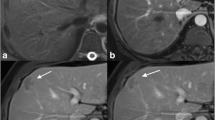Abstract
Purpose: To describe the Gd-BOPTA MRI findings of intrahepatic mass-forming type cholangiocarcinomas (IMCs), with emphasis on the hepatobiliary phase (HBP). Methods: We reviewed retrospectively 29 IMC patients who underwent Gd-BOPTA-MRI between June, 2004 and June, 2014. Images were acquired prior to, and after, administration of 15–20 mL of Gd-BOPTA in the dynamic phase (arterial phase, portal venous phase, and 3–5 min phase), 10–15-min late phase, and 2–3 h HBP phase. Results: In the dynamic phase, 27 (93%) lesions showed a peripheral rim-like enhancement in the arterial and portal venous phases, followed by progressive filling-in on the delayed images. In 14 (56%) cases, a hypointense peripheral rim was identified in the 10–15-min late phase, delineating a target pattern. In the HBP, the cholangiocarcinoma showed a diffuse, mainly central and inhomogeneous enhancement (cloud of enhancement) in 28 (96%) patients; in 23 (79%) cases, there was an association between cloud appearance and a hypointense peripheral rim, showing a target pattern. Conclusions: Gd-BOPTA MRI pattern of IMC on dynamic study is similar to that of conventional extracellular agents, that is peripheral enhancement with progressive and concentric filling of contrast material on delayed phases. At 10–15 min delayed phases, IMC shows often a peripheral hypointense rim consistent with a target appearance. In the HBP, due to progressive central enhancement (cloud) and peripheral hypointense rim, an higher number of tumors show a target appearance; this pattern is not specific and would also be expected to be seen in metastases from adenocarcinoma.




Similar content being viewed by others
Abbreviations
- IMC:
-
Intrahepatic mass-forming cholangiocarcinoma
- HBP:
-
Hepatobiliary phase
References
Nakeeb A, Pitt HA, Sohn TA, et al. (1996) Cholangiocarcinoma: a spectrum of intrahepatic, perihilar, and distal tumors. Ann Surg 224:463–473
Patel T (2011) Cholangiocarcinoma: controversies and challenges. Nat Rev Gastroenterol Hepatol 8:189–200
Tanimoto A, Lee JM, Murakami T, et al. (2009) Consensus report of the 2nd International Forum for Liver MRI. Eur Radiol 19(Suppl 5):S975–S989
Jeon TY, Kim SH, Lee WJ, Lim HK (2010) The value of gadobenatedimeglumine–enhanced hepatobiliary-phase MR imaging for the differentiation of scirrhous hepatocellular carcinoma and cholangiocarcinoma with or without hepatocellular carcinoma. Abdom Imaging 35:337–345
Kim YK, Lee JM, Kim CS (2004) Gadobenatedimeglumine–enhanced liver MR imaging: value of dynamic and delayed imaging for the characterization and detection of focal liver lesions. Eur Radiol 14:5–13
Gabata T, Matusi O, Kadoya M, et al. (1998) Delayed MR imaging of the liver: correlation of delayed enhancement of hepatic tumors and pathologic appearance. Abdom Imaging 23:309–313
Grazioli L, Bondioni MP, Faccioli N, et al. (2010) Solid focal liver lesions: dynamic and late enhancement patterns with the dual phase contrast agent gadobenatedimeglumine. J Gastrointest Cancer 41(4):221–232
Hwang HS, Kim SH, Jeon TY, et al. (2009) Hypointense hepatic lesions depicted on gadobenatedimeglumine-enhanced three-hour delayed hepatobiliary-phase MR imaging: differentiation between benignancy and malignancy. Korean J Radiol 10:294–302
Schneider G, Altmeyer K, Kirchin MA, et al. (2007) Evaluation of a novel time-efficient protocol for gadobenatedimeglumine (Gd-BOPTA)-enhanced liver magnetic resonance imaging. Invest Radiol 42:105–115
Hamrick-Turner J, Abbitt PL, Ros PR (1992) Intrahepatic cholangiocarcinoma: MR appearance. AJR 158:77–79
Vilgrain V, Van Beers BE, Flejou JF, et al. (1997) Intrahepatic cholangiocarcinoma: MRI and pathologic correlation in 14 patients. J Comput Assist Tomogr 21(1):59–65
Ros PR, Buck JL, Goodman ZD, ViamonteRos AM, Olmsted WW (1988) Intrahepatic cholangiocarcinoma: radiologic-pathologic correlation. Radiology 167:689–693
Maetani Y, Itoh K, Watanabe C, et al. (2001) MR imaging of intrahepatic cholangiocarcinoma with pathologic correlation. AJR 176:1499–1507
Yoshida Y, Imai Y, Murakami T, et al. (1999) Intrahepaticcholangiocarcinoma with marked hypervascularity. Abdom Imaging 24:66–68
Yoshikawa J, Matsui O, Kadoya M, et al. (1992) Delayed enhancement of fibrotic areas in hepatic masses: CT-pathologic correlation. J Comput Assist Tomogr 16(2):206–211
Kim SH, Lee CH, Kim BH, et al. (2012) Typical and atypical imaging findings of intrahepatic cholangiocarcinoma using gadolinium ethoxybenzyldiethylenetriaminepentaacetic acid-enhanced magnetic resonance imaging. J Comput Assist Tomogr 36(6):704–709
Kajiyama K, Maeda T, Takenaka K, Sugimachi K, Tsuneyoshi M (1999) The significance of stromal desmoplasia in intrahepatic cholangiocarcinoma: a special reference of “scirrhous-type” and “nonscirrhous-type” growth. Am J Surg Pathol 23:892–902
Lacomis JM, Baron RL, Oliver JH 3rd, Nalesnik MA, Federle MP (1997) Cholangiocarcinoma: delayed CT contrast enhancement patterns. Radiology 203(1):98–104
Mahfouz AE, Hamm B, Wolf KJ (1994) Peripheral washout: a sign of malignancy on dynamic gadolinium enhanced MR images of focal liver lesions. Radiology 190:49–52
Jeong HT, Kim MJ, Chung YE, et al. (2013) Gadoxetate disodium-enhanced MRI of mass-forming intrahepatic cholangiocarcinomas: imaging-histologic correlation. AJR Am J Roentgenol 201(4):W603–W611
Kang Y, Lee JM, Kim SH, Han JK, Choi BI (2012) Intrahepatic mass-forming cholangiocarcinoma: enhancement patterns on gadoxetic acid-enhanced MR images. Radiology 264(3):751–760
Worawattanakul S, Semelka RC, Noone TC, et al. (1998) Cholangiocarcinoma: spectrum of appearances on MR images using current techniques. Magn Reson Imaging 16(9):993–1003
Schlund JF, Semelka RC, Kettritz U, et al. (1996) Correlation of perfusion abnormalities on CTAP and immediate postintravenous gadolinium-enhanced gradient echo MRI. Abdom Imaging 21:49–52
Soyer P, Bluemke DA, Vissuzaine C, et al. (1994) CT of hepatic tumors: prevalence and specificity of retraction of the adjacent liver capsule. AJR 162:1119–1122
Author information
Authors and Affiliations
Corresponding author
Rights and permissions
About this article
Cite this article
Mamone, G., Marrone, G., Caruso, S. et al. Intrahepatic mass-forming cholangiocarcinoma: enhancement pattern on Gd-BOPTA-MRI with emphasis of hepatobiliary phase. Abdom Imaging 40, 2313–2322 (2015). https://doi.org/10.1007/s00261-015-0445-5
Published:
Issue Date:
DOI: https://doi.org/10.1007/s00261-015-0445-5




